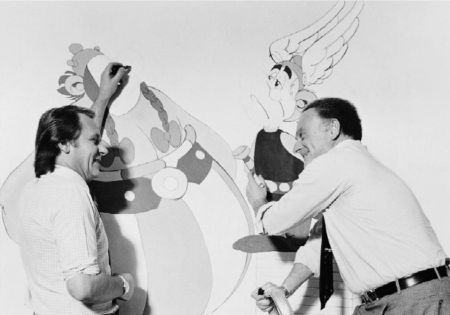 René Goscinny
René Goscinny
Born on 14 August 1926 in Paris, as the son of a Polish father and a Ukrainian mother.
He spent his childhood in Argentina, where he discovered literature and comic books early.
In 1945, He became an assistant illustrator with an advertising agency in France, before an invitation from an uncle led him to leave for New York.
After his French military service, he crossed the Atlantic, where he met the team behind MAD Magazine (Willy Elder, Harvey Kurtzman and John Severin) and worked as an illustrator for the comedy publication. It was also there that he met Morris, who he would go on to work with on Lucky Luke starting in 1955.
In 1950, René moved to Brussels and began working with Jean-Michel Charlier for the press agency, World Press. That year, he was to produce and illustrate his 1st comic book: Dick Dicks.
The 1950s were a rich period full of collaboration with different illustrators who helped set his genius free: Spaghetti with Attanasio, Strapontin with Berck, Prudence Petitpas with Maréchal, Modeste et Pompon with Franquin, and more.
On 5 November 1977, he died suddenly at the age of 51. His immense talent meant that his characters, like Asterix, Lucky Luke, Iznogoud and Petit Nicolas lived on after his death.
 Albert Uderzo
Albert Uderzo
He was born on 25 April 1927 to Italian parents.
From ten years old, his ambition was to work in the cartoon business, and he began sketching characters featuring big noses: Stupido.
In 1945, he won his first contract as an illustrator at the publishing house Editions Du Chêne. During this time, he gained vast experience creating new heroes such as Flamberge, Clopinard, Zartan, Zidore and Belloy l’Invulnerable.
These characters were the first in a long line of muscular, ‘pumped up’ heroes of which Albert was particularly fond.
In 1947, he became a reporter and illustrator for the newspaper France Dimanche and worked for two small press agencies, World Press and International Press, where he met Jean-Michel Charlier and Victor Hubinon, who would become two of the biggest names in comic books.
 Their creations
Their creations
In 1951, Albert Uderzo learnt that a new contributor was coming, René Goscinny. This was the beginning of an exceptional friendship in every way. Their first collaboration in 1951 marked the birth of Oompah-Pah, Jehan Pistolet and Luc Junior.
In 1956, René Goscinny was actively involved with Albert Uderzo, Jean-Michel Charlier and Jean Hébrard in creating the press agency Edipresse and the advertising agency
Edifrance, that finally gave them the opportunity to express themselves with an entirely free rein.
Albert Uderzo produced up to nine strips a week.
In 1959 they created Pilote, a major weekly newspaper aimed at a young audience. It was an immediate success, all 300,000 copies printed sold out on the first day. The first edition of Pilote presented the first strip illustrating the adventures of Asterix the Gaul.
1967: Astérix & the Normans draws in 1 billion of album sales.
 1974: They create Studio Idefix, producing The Twelve Tasks of Asterix for the cinema as well as many more cartoons.
1974: They create Studio Idefix, producing The Twelve Tasks of Asterix for the cinema as well as many more cartoons.
1977: The tragic news of René Goscinny’s death came on 5 November 1977. He was 51. His immense talent meant that his characters live on after his death.
René Goscinny collaborated on several other comic strips: 1961’s Iznogoud (Tabary), 1956’s Le Petit Nicolas (Sempé), 1955’s Lucky Luke (Morris), 1961’s Valentin (Tabary), 1965’s Les
Dingodossiers (Gotlib), etc.
1979: Albert Uderzo continues to work alone on the adventures of the heroic Gaul, creating the publishing house, Éditions Albert René. Armed with 26 years of experience of working with René Goscinny, Albert Uderzo writes and illustrates new comic books.
2011: Hachette Livre takes over Éditions Albert René. After more than 70 years of drawing, Albert Uderzo decides to put down his pencils, saying “I need a bit of a rest.”But fascinated by drawing, he continues to enthusiastically work on his characters and works closely with the authors of the new albums!
24th March 2020: Albert Uderzo died at home in Neuilly. His virtuoso drawing had the same panache, whether it was in realist work or the more humorous style, that he brought to his unique graphic creations. He will influence illustrators for many years to come and will continue to dazzle and entertain millions of readers.




